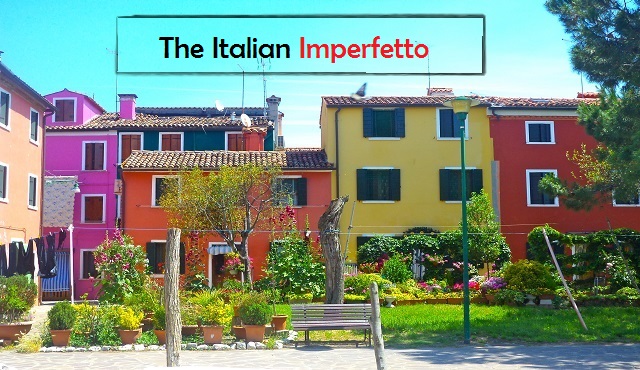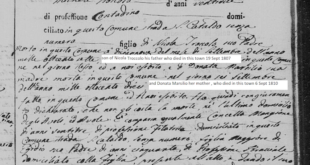If we want to make general statements in Italian about what has happened in the past, we must be willing to be a little imperfetto! The conjugation of the imperfetto past tense is fairly straightforward. The tricky part is knowing how to use this verb form.
The Italian imperfetto refers to the recent past, and is useful when describing events that happened frequently in the past without a specific time frame. The imperfetto in Italian translates into the simple past tense in English and also into “used to” or “was/were…ing.” Let’s learn how to form this tense, which is actually quite easy, as the same endings are added to the stems for the –are, -ere, and -ire verbs.
To change any infinitive verb into the imperfetto, first drop the -re from the -are, -ere, or –ire ending. This will give stems that will have the last letters as: a, e, and i. Then, just add the following endings to the stems for all three conjugations: vo, vi, va, vamo, vate, vano.
Let’s see how this works by conjugating some familiar verbs in the table below. The stressed syllables have been underlined for easy pronunciation. Notice how the stress falls on the syllable just prior to the ending we add for the io, tu, Lei/lei/lui and loro forms. For the noi and voi forms, the stress instead falls on the first syllable of the ending that is added.
Imperfetto Conjugation
| Abitare
(lived) |
Vedere
(saw) |
Dormire
(slept) |
|
| io | abitavo | vedevo | dormivo |
| tu | abitavi | vedevi | dormivi |
| Lei/lei/lui | abitava | vedeva | dormiva |
| noi | abitavamo | vedevamo | dormivamo |
| voi | abitavate | vedevate | dormivate |
| loro | abitavano | vedevano | dormivano |
Below is an excerpt from a conversation between two women, Francesca and Caterina. Caterina is an Italian-American girl who is visiting Francesca and her family in Italy during the Italian holiday of Ferragosto in August. Francesca meets Caterina on the beach and Francesca mentions that she saw Caterina talking to someone before her arrival. To describe this activity in the recent past, Francesca uses the imperfetto form in Italian.
If you would like to listen to the entire dialogue, recorded with an Italian-American and a native Italian speaker, just click on the link from the website Learntravelitalian.com: On the Beach at Last.
Francesca:
| Ciao, Caterina. Chi era la donna con cui parlavi? | Hi, Kathy. Who was the woman with whom you were speaking? |
Caterina:
| Si chiama Elena. L’ho conosciuta questa mattina. | Her name is Helen. I met her this morning. |
Francesca:
| Per quanto tempo hai parlato con Elena? | For how much time (how long) did you speak with Helen? |
Caterina:
| Parlavo con lei da pochi minuti quando sei arrivato tu. | I was speaking with her for a few minutes when you arrived. |
| Lei è molto simpatica. | She is very nice. |
| Speriamo di vederci dopo. | We hope to see each other later. |
You may have noticed from the previous dialogue that the imperfetto was used in certain situations, sometimes in combination with the passato prossimo past tense. If you need a refresher on when to use the passato prossimo, please see our previous blog: Past Tense Passato Prossimo: “Avere” vs. “Essere”?
So, when to use the imperfetto? Italians mainly use this tense to express an action that was done habitually in the past but is no longer being done. For instance, can you think of some things that might take place every day? Reading the paper, going to school, going to work, and eating breakfast, lunch and dinner? If you want to talk about how you’ve done these things in the past, use the imperfetto! Sentences that use the imperfetto in this way are translated into the simple present tense and often include an adverb of frequency. Several of these adverbs are listed in the following table:
Italian Adverbs of Frequency
| di solito | often times |
| spesso | very often |
| quasi sempre | almost always |
| sempre | always |
Di solito, io finivo la lezione all’una il lunedì.
Often times, I used to finish the class at one o’clock on Mondays.
Quando ero piccolo, andavo a casa di mia nonna molto spesso.
When I was small, I went to my grandmother’s house very often.
Quasi sempre mi sentivo male quando viaggiavo in barca.
I almost always felt sick when I traveled by boat.
The other translation of the imperfetto uses was/were -ing, and refers to an action performed in the past without mention of a particular starting or ending time. This is especially important if two things have happened in the past, in which case the imperfetto is used for the first action in order to describe the setting at the time of both actions. In this case, the completed action is given in the passato prossimo. From our dialogue:
Caterina:
| Parlavo con lei da pochi minuti quando sei arrivato tu. | I was speaking with her for a few minutes when you arrived. |
It is also necessary to use the imperfetto with the Italian verbs of thinking, believing, knowing and feeling — pensare, credere, sapere and sentire — in order to refer to situations in the past.
Other phrases that refer to a personal state of being in the past, such as being hungry or simply existing, use the imperfetto form of the verbs avere and essere.
The imperfetto conjugation of avere is regular:
io avevo, tu avevi, Lei/lei/lui aveva, noi avevamo, voi avevate, loro avevano.
The imperfetto conjugation of essere is irregular:
io ero, tu eri, Lei/lei/lui era, noi eravamo, voi eravate, loro erano.
To summarize… More uses for the imperfetto are listed below:
| Pensavo che… | I thought that… |
| Credevo che… | I believed that… |
| Non sapevo che… | I didn’t know that… |
| Mi sentivo male. | I was feeling badly. |
| Io avevo fame. | I used to be hungry. |
| Caterina era felice. | Kathy was happy. |
You will notice a common thread in the reasoning behind when to use the imperfetto: use the imperfetto when making generalizations about the past.
For a final exercise using the imperfetto, imagine you are a child and visited your Italian grandparents on their farm one summer. Tell a story in Italian about your daily routine. Use adverbs of frequency and the imperfetto to describe typical daily activities and how you felt living in the countryside. My attempt at this exercise is below.
Buon divertimento! Have fun!
Un giorno in fattoria: A day on the farm:
| Avevo dieci anni l’estate scorso. | I was 10 years old last summer. |
| Abitavo con mia nonna Maria e mio nonno Giuseppe durante l’estate e mi piaceva molto la compagna! | I was living with my grandmother Maria and my grandfather Joseph on their farm and I loved the country very much! |
| Di solito, io e nonna Maria preparavamo la prima colazione per la famiglia. | Usually, io e nonna Maria made breakfast for the family. |
| Quasi ogni giorno, andavo di fuori per guardare gli animali della fattoria. | Almost every day, I went outside to watch the animals on the farm. |
| Stavo molto bene in compagna. | I felt really good in the country. |
| L’aria era fresca e il cielo era sempre blu. | The air was fresh and the sky was always blue. |
| Durante i pomeriggi, io e nonno Giuseppe camminavamo con il nostro gregge di pecore in montagne. | During the afternoons, Grandpa Joseph and I walked with our herd of sheep in the mountains. |
| La sera, avevo molto fame! | In the evenings, I was very hungry! |
| Ma non avevo fame per molto tempo perché a casa, nonna Maria cucinava una cena meravigliosa! | But I was not hungry for very long, because back at home Grandmother Maria was cooking a wonderful dinner! |
Of course, there are many, many more routine activities that can happen in a single day than what we have listed here. You may want to keep a short diary to practice using the imperfetto. Every night before going to bed, write one or two sentences to describe in general how you felt during the day, or a habitual action that you performed. Soon it will be second nature to know when and how to use the Italian imperfetto!
Remember how to talk about the past using the imperfetto and
I guarantee you will use this Italian past tense every day!
*If you’d like to read earlier posts in the series, “Italian Phrases We Use EVERY Day!” just click HERE.
 Fra Noi Embrace Your Inner Italian
Fra Noi Embrace Your Inner Italian








Thank you so much – I am a Brit living in Italy and studying Italian. Most books describe the “how to” aspect of language in Italian, which of course defeats the object and leaves gaps in comprehension. You write clearly, and I find it a great help.
Prego! You’re welcome. And thank you for your kind comment. I always try to include points that I have discovered on my journey learning the Italian language and to use “real life” examples that others may find useful as well. The real trick in learning any language is to put all those grammar rules into practice!